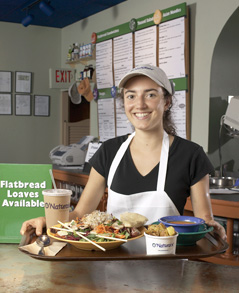The Other Fast Food Nation
Organic Choices for People on the Go
If Gary Hirshberg’s crystal ball is working properly, there are major changes coming to the fast-food industry in the next five years. Writing in 2002, the chairman and CEO of Stonyfield Farm Yogurt and self-confessed "pathological optimist," predicted that, a decade hence, "three national organic and natural fast food chains will be the third-, fourth- and fifth-largest fast-food chains in the U.S."

Hirshberg speculated that O"Naturals, the natural and organic fast-food eatery he founded in 2000, would be closing in on the number three spot by 2012, with hundreds of locations nationwide.
The Portland, Maine-based chain currently operates three restaurants in New England and one franchised location, which opened in Kansas in late 2006.
Organic Growth
These are promising times for the organic foods industry. Retailing’s 800-pound gorilla—Wal-Mart—moved into the business and consumers are expressing an ever-increasing interest in organic, natural and locally grown foods.
The Organic Trade Association says organic products will be commonplace by 2025. In 2003, the organic foods market was worth $10.8 billion and it is expected to hit $46 billion by 2010. Growth in organic foods averaged a brisk 19.5 percent annually from 1997 to 2003. A study commissioned by Whole Foods Market found that nearly two-thirds of U.S. consumers purchased organic goods in 2005, up 17 percent from 2003 and 2004.
Some of fast food’s big guns have made tentative steps toward healthier menus. Several chains, including McDonald"s, KFC, Burger King and Wendy"s, have reduced or eliminated trans fats. In 2002, the year Burger King first offered its BK Veggie Burger, Chipotle Mexican Grill began using naturally raised pork in its carnitas, later adding naturally raised chicken and beef to the menu. In 2003, McDonald’s began selling organic milk in its British restaurants.
One Step Further
Several chains have emerged recently that take the notion of healthy fast food even further. Dino Lambridis, co-founder of EVOS, claims that the chain (in business for over a decade) is a pioneer in this field. "We are one of the oldest fast casual restaurant chains that offers healthier fare," Lambridis says.
EVOS uses hormone-free chicken and hormone and antibiotic-free free-range beef. Menu items include a Free-range Steakburger, All-Fruit Smoothies, salads made with organic field greens and baked Airfries with a fat content supposedly 50 to 70 percent lower than deep-fried ones.
Lambridis and college pals Alkis Crassas and Michael Jeffers conceived of EVOS in 1994 as an alternative to standard fast-food fare. Today the company operates five locations in the Tampa-St. Petersburg area, and Lambridis says the company is looking to franchise in 12 western states.

Better Burger NYC is the brainchild of Louis Lanza, the owner-chef behind Josie’s and a few other local full-serve joints. The restaurant debuted in 2001 and now operates three Manhattan locations.
Among the attractions at Better Burger: antibiotic- hormone- and nitrate-free (and sometimes organic) meat and poultry; organic, air-baked fries; expeller-pressed extra virgin olive and canola oils; smoothies and snacks made with at least 85 percent organic ingredients; and even an organic condiment bar serving Karma Ketchup.
In addition to natural and organic foods, Burgerville’s 39 Oregon and Washington locations place a strong emphasis on using local ingredients. The Vancouver, Washington-based chain was founded in 1961 by George Propstra, and is owned and operated by The Holland.
Burgerville’s parent company has focused on sustainable practices since 1922 and works with local growers and farmers who provide the company with all-natural Oregon County Beef, Alaska halibut, Walla Walla onions and Tillamook cheese. In the early 1990s, Burgerville further distanced itself from traditional fast food by offering seasonal items like sweet potato fries, huckleberry milkshakes and strawberry shortcake.
"We realized that we had to identify something that set us apart from the rest," Jack Graves, Burgerville’s operations director, explained in 2004. The company’s commitment to local foods and seasonal specials has brought prosperity even in tough times. In early 2004, Burgerville’s sales jumped 14 percent, even after a Northwestern mad cow disease outbreak.
Burgerville’s emphasis on local foods and sustainable practice included, in 2005, using wind energy to power its restaurants and, in 2006, switching to trans fat-free oils, which predated most big fast food chains. All of which won praise from one of fast food’s toughest critics, Fast Food Nation author, Eric Schlosser.
Air-baked fries seem to be de rigueur in the world of healthy fast food and Topz is no exception. The first restaurant opened in 1998 after founder Mark Avila Matters vowed to devise a hamburger with half the fat of others. Today the chain has nine locations in California, Michigan and Texas and lays claim to the "Leanest Burgers in America!" While the array of organic and natural foods is similar to that of other healthy chains, Organic To Go approaches the concept a little bit differently, offering freshly prepared "grab-and-go" fare, as well as delivery and catering options. The Seattle-based company, the first fast-casual restaurant and retailer to receive organic certification, currently operates nine locations in Washington and southern California.
It seems Gary Hirshberg’s notion that healthy fast food will become ubiquitous wasn’t so much farfetched as a bit bullish. But when it comes to those hundreds of locations, don’t count O"Naturals out yet. After announcing it would franchise the concept in early 2006, the company said it received more than 1,000 inquiries from around the world—including some from current and former fast-food franchisees.
WILLIAM I. LENGEMAN III is a Pen-nsylvania-based freelance food writer.

